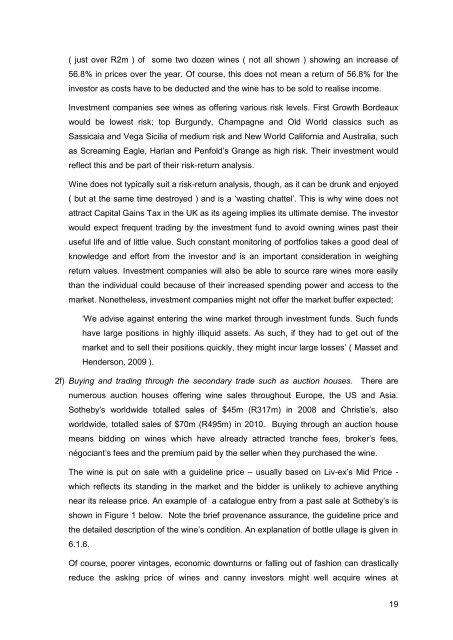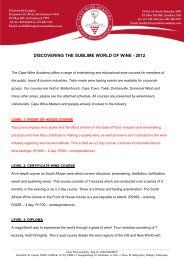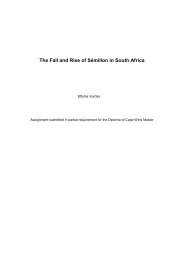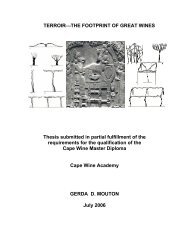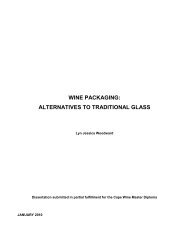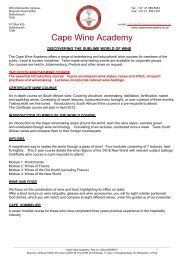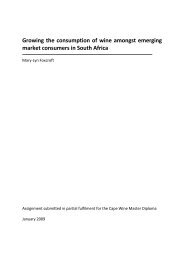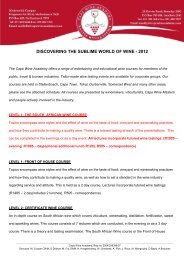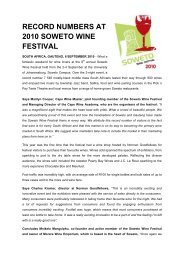Wine Investment in South Africa - Cape Wine Academy
Wine Investment in South Africa - Cape Wine Academy
Wine Investment in South Africa - Cape Wine Academy
You also want an ePaper? Increase the reach of your titles
YUMPU automatically turns print PDFs into web optimized ePapers that Google loves.
( just over R2m ) of some two dozen w<strong>in</strong>es ( not all shown ) show<strong>in</strong>g an <strong>in</strong>crease of<br />
56.8% <strong>in</strong> prices over the year. Of course, this does not mean a return of 56.8% for the<br />
<strong>in</strong>vestor as costs have to be deducted and the w<strong>in</strong>e has to be sold to realise <strong>in</strong>come.<br />
<strong>Investment</strong> companies see w<strong>in</strong>es as offer<strong>in</strong>g various risk levels. First Growth Bordeaux<br />
would be lowest risk; top Burgundy, Champagne and Old World classics such as<br />
Sassicaia and Vega Sicilia of medium risk and New World California and Australia, such<br />
as Scream<strong>in</strong>g Eagle, Harlan and Penfold’s Grange as high risk. Their <strong>in</strong>vestment would<br />
reflect this and be part of their risk-return analysis.<br />
<strong>W<strong>in</strong>e</strong> does not typically suit a risk-return analysis, though, as it can be drunk and enjoyed<br />
( but at the same time destroyed ) and is a ‘wast<strong>in</strong>g chattel’. This is why w<strong>in</strong>e does not<br />
attract Capital Ga<strong>in</strong>s Tax <strong>in</strong> the UK as its age<strong>in</strong>g implies its ultimate demise. The <strong>in</strong>vestor<br />
would expect frequent trad<strong>in</strong>g by the <strong>in</strong>vestment fund to avoid own<strong>in</strong>g w<strong>in</strong>es past their<br />
useful life and of little value. Such constant monitor<strong>in</strong>g of portfolios takes a good deal of<br />
knowledge and effort from the <strong>in</strong>vestor and is an important consideration <strong>in</strong> weigh<strong>in</strong>g<br />
return values. <strong>Investment</strong> companies will also be able to source rare w<strong>in</strong>es more easily<br />
than the <strong>in</strong>dividual could because of their <strong>in</strong>creased spend<strong>in</strong>g power and access to the<br />
market. Nonetheless, <strong>in</strong>vestment companies might not offer the market buffer expected;<br />
‘We advise aga<strong>in</strong>st enter<strong>in</strong>g the w<strong>in</strong>e market through <strong>in</strong>vestment funds. Such funds<br />
have large positions <strong>in</strong> highly illiquid assets. As such, if they had to get out of the<br />
market and to sell their positions quickly, they might <strong>in</strong>cur large losses’ ( Masset and<br />
Henderson, 2009 ).<br />
2f) Buy<strong>in</strong>g and trad<strong>in</strong>g through the secondary trade such as auction houses. There are<br />
numerous auction houses offer<strong>in</strong>g w<strong>in</strong>e sales throughout Europe, the US and Asia.<br />
Sotheby’s worldwide totalled sales of $45m (R317m) <strong>in</strong> 2008 and Christie’s, also<br />
worldwide, totalled sales of $70m (R495m) <strong>in</strong> 2010. Buy<strong>in</strong>g through an auction house<br />
means bidd<strong>in</strong>g on w<strong>in</strong>es which have already attracted tranche fees, broker’s fees,<br />
négociant’s fees and the premium paid by the seller when they purchased the w<strong>in</strong>e.<br />
The w<strong>in</strong>e is put on sale with a guidel<strong>in</strong>e price – usually based on Liv-ex’s Mid Price -<br />
which reflects its stand<strong>in</strong>g <strong>in</strong> the market and the bidder is unlikely to achieve anyth<strong>in</strong>g<br />
near its release price. An example of a catalogue entry from a past sale at Sotheby’s is<br />
shown <strong>in</strong> Figure 1 below. Note the brief provenance assurance, the guidel<strong>in</strong>e price and<br />
the detailed description of the w<strong>in</strong>e’s condition. An explanation of bottle ullage is given <strong>in</strong><br />
6.1.6.<br />
Of course, poorer v<strong>in</strong>tages, economic downturns or fall<strong>in</strong>g out of fashion can drastically<br />
reduce the ask<strong>in</strong>g price of w<strong>in</strong>es and canny <strong>in</strong>vestors might well acquire w<strong>in</strong>es at<br />
19


